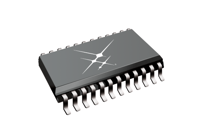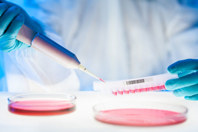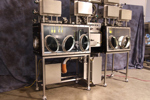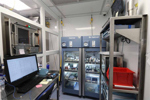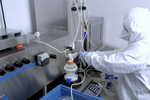Turbine
PRODUCTS
-
The Si830x provides four high-side or low-side switches with low RON. These switches are ideal for driving resistive and inductive loads like solenoids, relays, and lamps commonly found in industrial control systems like Programmable Logic Controllers (PLC).
-
PHCbi brand's 18.6 cu.ft (528L) ultra-low temperature freezer operates on 220V and features VIP Plus vacuum insulated panels to deliver reliable temperature uniformity throughout the chamber. ENERGY STAR® Certified.
-
Comprehensive analytical and device testing services are available for injectable drugs, ensuring optimal primary packaging, compliance, and reliability throughout the product development lifecycle.
-
Many cell types require highly-specialized formulations in order to achieve optimal performance. Build a media from scratch that meets your specific requirements, regardless of the complexity.
-
From regulatory pathway selection to patient recruitment challenges to navigating the volume of data to collect and clean — a rare disease therapy requires an extraordinary amount of coordination.
WHITE PAPERS AND CASE STUDIES
-
Cleanroom Recovery. Proven Results. Contamination Control Case Studies
Through this collection, review how a proven, automated solution can help facilities stay compliant, operational, and protected — whether in a crisis or during planned maintenance.
-
Support Digital Transformation And Enable Collaboration Between Teams
Discover the solution PharmaEssentia, a Taiwanese pharmaceutical company, chose to help teams capture, structure, and interrogate data from a single source, making their collaboration more efficient.
-
A Biosafety Cabinet For Virology Studies And Disease Surveillance
Discover how Germfree tackled a unique challenge from the Public Health Agency of Canada by designing a custom Class III biosafety cabinet for advanced virology studies and disease surveillance.
-
2R Vials And Deep Cold Storage - Determining Mechanical & CCI Performance
Review the implications of this study on the storage of sensitive molecules that require deep-cold storage and learn how 2R Fina glass vials are poised to enhance cold storage practices.
-
Custom Mobile Pharmacy Cleanroom Trailer For Oncology Infusion Pharmacy Services
Gain insight into the mobile cleanroom that was created to accommodate the needs of Moffitt Cancer Center's Oncology Infusion Pharmacy Services and adhere to USP <797> and <800> standards.
-
Improving Patient Health And Safety: Medical Affairs
A medical affairs department needed leaders with scientific and project management expertise. With no time for training or risk tolerance, a consultant was hired to align activities with development and launch plans.
-
eClinical Platform Accelerates COVID-19 Treatment Trial By 2 Weeks
Examine a COVID-19 treatment trial that utilized integrated EDC, eConsent, eCOA, RTSM, and TeleVisit solutions, all within a single platform, to address three critical challenges.
-
Professional Services Expedite Hospital's Study Process
Explore the details of a transformative partnership where a children's hospital was able to overcome coverage analysis and budget negotiation issues despite a significant staff turnover.
-
Performance Dashboards Development
Learn about a biotech company's successful implementation of a two-level KPI dashboard system. This enhanced performance monitoring, aligned departmental goals, and strengthened team communication.
-
Delivering Apheresis Treatment From The USA To The UK Within 24 Hours
The goal was to perform next-day collection of temperature-sensitive tumor material for an urgent patient treatment. A flexible mitigation strategy was essential to manage short turnaround.
-
Breaking Barriers In Malaria Prevention With A Mobile Cleanroom
The delivery of this mobile cGMP cleanroom facility to ACT showcases Germfree’s commitment to providing innovative solutions that meet clients' unique needs and contribute to advancing healthcare.
-
Study Viral Infection In Resting Humans CD4+ T Cells With Synthetic sgRNAs
Discover how Synthego's proprietary synthetic sgRNA, combined with Lonza’s 4D-Nucleofector®, enabled highly efficient gene editing in resting human CD4+ T cells.
NEWS
-
Biogen Receives Positive CHMP Opinion For TOFIDENCE™ (tocilizumab), A Biosimilar Referencing ROACTEMRA®4/25/2024
Biogen Inc. (Nasdaq: BIIB) today announced that the Committee for Medicinal Products for Human Use (CHMP) of the European Medicines Agency (EMA) adopted a positive opinion for TOFIDENCE™ (tocilizumab), a biosimilar monoclonal antibody referencing ROACTEMRA®1.
-
Silo Pharma Expands Intellectual Property Portfolio With Patent Application For Exclusively Licensed Alzheimer's Drug4/28/2025
Silo Pharma, Inc. (Nasdaq: SILO) (“Silo” or the “Company”), a developmental stage biopharmaceutical company focused on novel therapeutics and drug delivery systems, today announced the filing of a patent application with the U.S. Patent and Trademark Office (USPTO) focused on the neurology drug SPC-14, an intranasal compound for the treatment of Alzheimer’s disease (AD) exclusively licensed to Silo Pharma from Columbia University.
-
Celestia TTI Brings Unique GaN Based SSPAs In DBS Band To Broadcast Satcom5/16/2024
Satellite operators running large teleport operations and satellite broadcasters seeking the ultimate technology to power their businesses now have a range of options to choose from thanks to a new generation of GaN SSPAs in DBS introduced to the market by Celestia TTI.
-
Naia Prepares First Production Of GRS-Certified Yarn2/20/2024
In a significant achievement for Eastman, Naia Renew cellulosic fiber has received the Global Recycled Standard (GRS) certification. This certification validates Naia Renew’s certified recycled content, chain of custody, social and environmental practices, and chemical restrictions.
-
Redex Preloaded Systems Deliver Precise Positioning For Machine Tools1/16/2025
Redex is pleased to announce its patented DualDRIVE and TwinDRIVE preloading technologies now give CNC machine designers several ways to build a zero backlash system.
ABOUT
About Nutrient Removal
Nutrient removal from wastewater consists of treating wastewater to remove nitrogen and phosphorus before it reenters natural waterways. High levels of nitrogen and phosphorus in wastewater cause eutrophication, a process where excess nutrients stimulate excessive plant growth such as algal blooms and cyanobacteria. The decomposition of the algae by bacteria uses up the oxygen in the water causing other organisms to die. This creates more organic matter for the bacteria to decompose. In addition, some algal blooms can produce toxins that contaminate drinking water supplies.
As authorized by the Clean Water Act, the National Pollutant Discharge Elimination System (NPDES) permit program regulates point sources, such as municipal wastewater treatment plants, that discharge pollutants as effluent into the waters of the United States. In recent years, many of the States’ environmental bodies have lowered nutrient limits to arrest eutrophication. Maryland’s effort to protect the Chesapeake Bay and its tidal tributaries is perhaps the most notable example of nutrient removal in the US. Nutrient removal continues to be a growing area of focus for wastewater treatment throughout the world.
The removal of nitrogen and phosphorus require different nutrient removal processes. To remove nitrogen, the nitrogen is oxidized from ammonia to become nitrate through a process called nitrification. This process is then followed by denitrification where the nitrate is reduced to nitrogen gas which is released to the atmosphere and removed from the wastewater.
Nitrification is a two-step aerobic process which typically takes place in aeration tanks. Denitrification requires anoxic conditions to encourage the appropriate biological conditions to form. The activated sludge process is often used to reduce nitrate to nitrogen gas in anoxic or denitrification tanks.
Phosphorus can be removed biologically using polyphosphate accumulating organisms (PAOs) which accumulate large quantities of phosphorus within their cells and separate it from treated water. Phosphorus removal can also be achieved by chemical removal. Once removed as sludge, phosphorus may be stored in a land fill. However, many municipalities and treatment facilities are looking to resell the biosolids for use in fertilizer.

